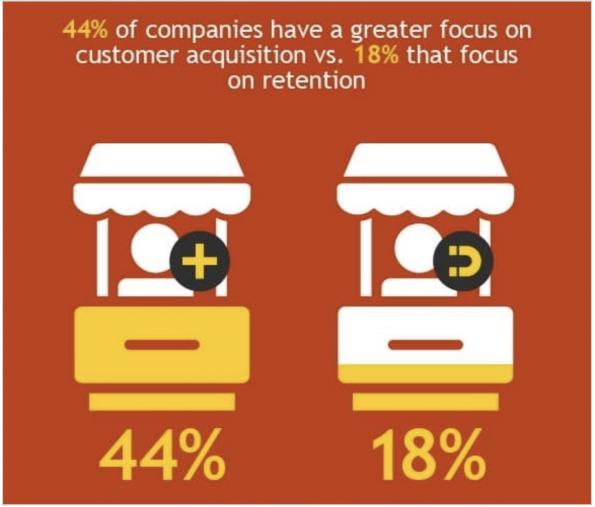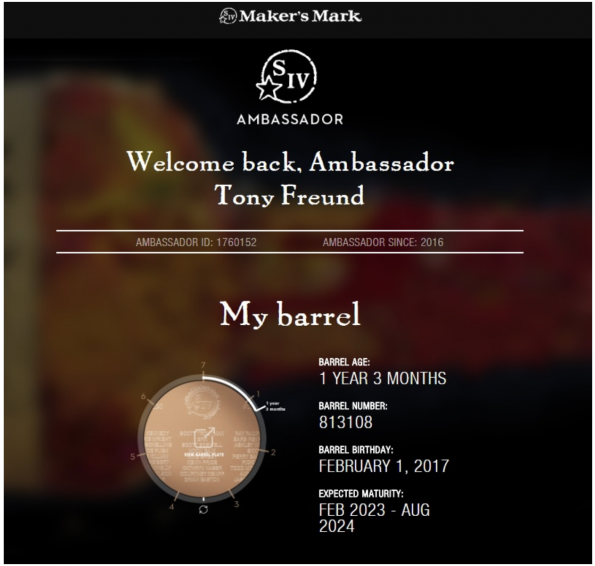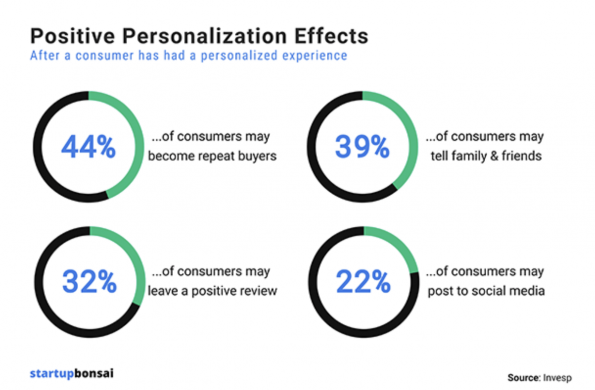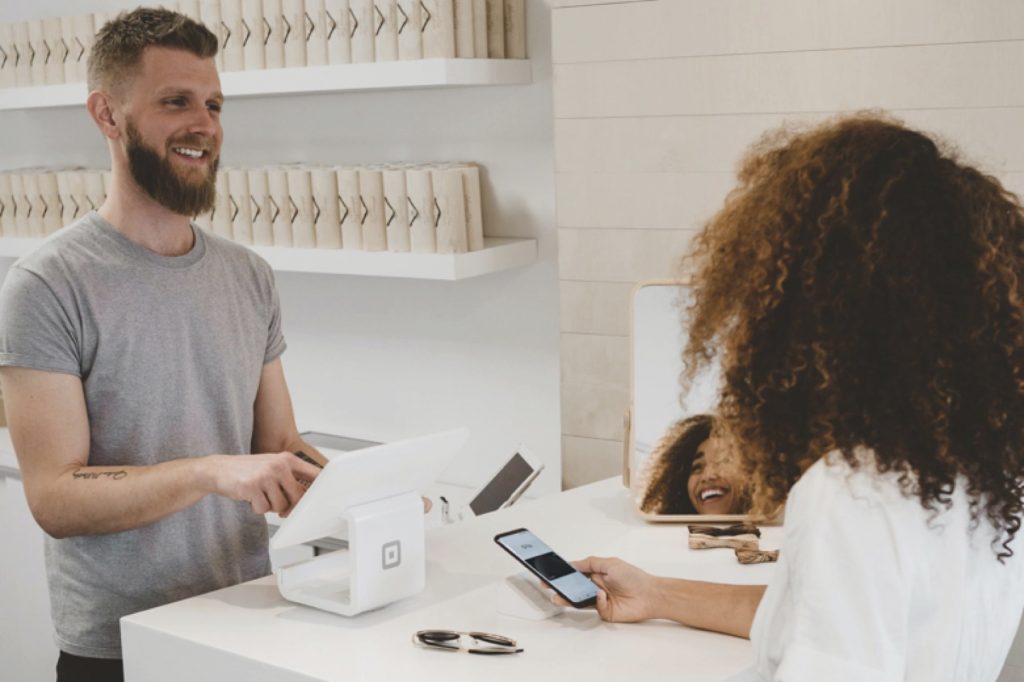Life After the Funnel: 6 Reasons why You’re Neglecting eCommerce Customer Retention
Guiding your customer from first impression to checkout may seem tricky, but retaining them is even harder.
A successful ecommerce business is built on customer loyalty, positive feedback and repeat purchasing. If you want your brand reputation to soar, it’s time to step away from acquisitions and pour focus into your eCommerce customer retention strategy.
Don’t just take our word for it. Studies show that just a 5% increase in retention rates could see increased profits of 25-95%.
However, in a competitive online landscape, only 18% of business leaders shift their focus to customer retention.

(Image Source: The Next Scoop)
Just under half of all ecommerce startups spend their monthly marketing budget on creative campaigns, social media targeting and traffic-generating strategies. While these acquisition tactics draw one-time consumers in, without an effective post-funnel plan, you’ll be repeating this process over and over again.
Let’s delve into life after the funnel. Stick with us as we reveal why customer retention is vital for ecommerce success and uncover how you could be neglecting your customers without even knowing.
You’re too focused on getting new customers
When growing your ecommerce business, it’s important to spread the word. Target large demographics, drop a creative campaign on social media and just don’t forget about the customers who have already converted.
Businesses that are too tied up in scoring new leads are more likely to neglect their current customer base. Not only is it five times more expensive to acquire a new customer than nurture an existing one, but studies have shown that a loyal customer is much more likely to repeat purchase than a new prospect is to convert.
“After operating my own startup marketing agency, I discovered that retaining and nurturing existing clients had much better ROI than on-boarding new ones because you already have existing manpower dedicating time on these operations and don’t need to initiate a new process,” says Yoav Vilner, CEO of Walnut.io. “Then, if clients are already paying you monthly, they are accustomed to it, and you can offer more services because of the trust you’ve built. Getting the first dollar from a new client is much more time-consuming.”
While acquisition efforts can increase the number of customers entering the checkout, you must balance this with a eCommerce customer retention strategy in order to maximise the value of the customers you’ve already converted.
You’re not segmenting your customer base
In order to retain customer interest, you need to get to know your conversions post-funnel. Instead of sending out the same product recommendations to every contact on the subscriber list, marketers must delve deeper into their consumer’s individual interests, needs and desires.
The key here is to delve deeper into the data. Start segmenting your customer base into groups depending on factors such as:
- Demographic age
- Geographic location
- Buying history
- Behavioural characteristics
Employing a well-designed segmentation strategy to your customer base can drive a future of customised consumer targeting. From personalised emails that offer discounts for customer-specific products to recommending location-based services and events. The company closest to its customer often wins the purchase.
Etsy showcases a really great example of the benefits of customer segmentation. Collecting data from consumer buying history, this retailer sends out personalised, targeted emails when a customer’s ‘favourite’ product goes on sale.
The way you segment your consumers should be personalised to your specific ecommerce store. For example, if you’re an international brand, location-based segmentation could be a great place to start. However, if you’re working on a smaller scale, you could use a segmentation strategy to target dormant customers and frequent window shoppers.
You don’t reward customer loyalty
Are you taking your customers for granted? Businesses that are preoccupied with increasing acquisition often forget to show appreciation to their remaining customers. If you fail to reward customer loyalty, the relationship will quickly go stale, and the likelihood of a repeat purchase starts to dwindle.
Many ecommerce businesses roll out the red carpet for new customers. From exclusive offers to frequent retargeting emails, many online stores pull out all the stops to get a prospect over the finishing line.
However, if this special treatment does not continue, a customer is left feeling neglected. In order to boost your customer appreciation, it’s important to continue communicating with your customer base and reward their loyalty with discounts, personalised product deals and perks for recommending the brand to a friend.
Take the famous bourbon brand Maker’s Mark as a great example of rewarding loyalty. After introducing their Ambassador program, they have become a pioneer in creative retention strategy.
In exchange for sharing their preference for Maker’s bourbon with friend and family, customers receive a number of exciting perks such as their own personalised barrel of bourbon and a special brass plaque with their name on it.

(Image Source: ABV Network)
This is a creative way to establish a loyal connection with repeat customers. Better still, with the promise of a personalised product, the company acquired more new customers than ever before too, alongside a whopping 110,000 people who were encouraged to tour the physical distillery.
Rewarding refers is an easy way to boost consumer eCommerce customer retention rates while onboarding new customers in seconds.
You’re ignoring customer feedback
Ecommerce retailers must realise that negative feedback is a gift. If a consumer offers you feedback, they are invested enough in the product to potentially engage with your business once again.
The key here is to stop ignoring customer feedback and turn each comment into something positive. Feedback does not only give a brand things to work on but can be starting point for a new purchase journey for the customer. Reply back to negative feedback with discounts and offers, and do everything in your power to rectify the mistake you made.
Taking time to acknowledge feedback builds new levels of trust with returning customers. If you go out of your way to improve their experience with your brand, they are twice as likely to repeat buy and recommend your services to a friend. When you build your website, make it easy for your consumers to connect with members of your team by adding feedback forms and opportunities to book call appointments.
VP of ShopShops, Virginia Lee, says that brands must get more creative in the way that they deal with consumer feedback. Opening up a responsive line of communication is vital.
“We have a WeChat group dedicated to our VIP customers to keep an open line of communication. We use this group to solicit feedback as well as give them early access to shopping events, exclusive discounts, and other perks,” she comments. “The nature of our live stream business is to make our customers feel like they’re shopping with a trusted friend (virtually). Enabling frequent communication with our audience helps establish this relationship.”
You keep changing your brand image
Did you know that 65% of a company’s revenue comes from existing customers rather than new acquisitions? If you’re constantly switching up your brand to draw in new demographics, you put yourself at risk of losing your current one.
With an older generation of customers in particular, brand familiarity builds trust and encourages a loyal line of repeat purchasing. If you suddenly switch up your logo or change your product direction, these new additions to your brand image could scare loyal customers away.
Instead, it’s important to transform your brand image in line with demographic trends. If you follow in the footsteps of your audience’s natural evolution, you’ll find that your customer retention rates stay high.
You lack a personal touch
Making a personal connection with each and every one of your consumers is worth the effort. In fact, a whopping 80% of consumers claim that they are more likely to make a repeat purchase if a brand offers them a personalised shopping experience.

(Image Source: Startup Bonsai)
As you can see above, prioritising personalisation in your eCommerce customer retention strategy could set you on course for more repeat purchases, positive reviews and brand referrals.
Retention-inspired personalisation could look like customised birthday emails offering personal discounts or even reaching out directly to loyal buyers for specific feedback on how to optimise your service or fix a customer service issue.
“I like to reach out when there is a customer service issue,” says the CEO of Swap Society, Nicole Robertson. “In an age of artificial intelligence and overseas customer service, it’s my experience that people really enjoy a personal touch and know that I am truly invested in their experience. We have a very low attrition rate and are working hard every day to keep it that way.”
Customising a customer’s experience post-funnel is a great way to make them feel special and ensure that they stick around.
Finding a balance between acquisition and retention
As the ecommerce sector heats up, it’s important to find a positive balance between finding new customers and nurturing your current ones.
Widening the net for potential prospects is exciting and can drive large influxes of traffic to your site, for some of the best marketing comes from consumer word of mouth.
If you nurture your loyal customers, they’ll repay you with positive feedback and constant referrals. Remember, your business only exists because of the customers that keep it alive. If you take the time to look after your customers, they’ll be sure to look after you. ECommerce customer retention is critical to your business success.

